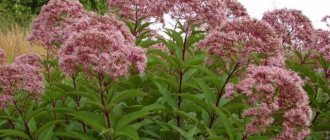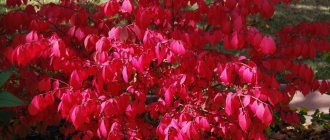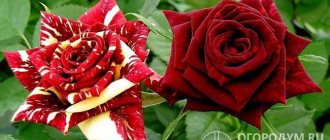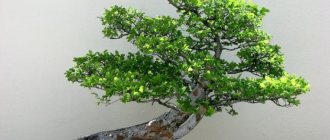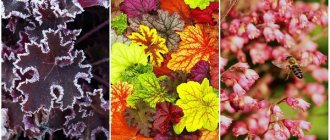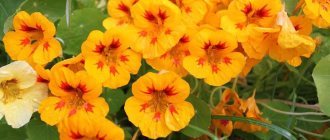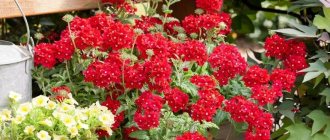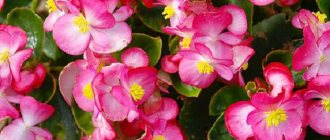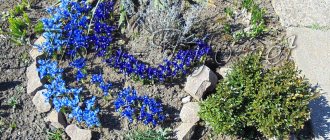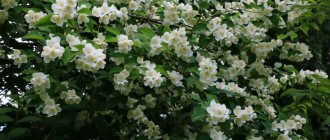Summer residents call this low, herbaceous, profusely flowering plant with a scattering of miniature blue flowers - blue-eye, forget-me-not, false forget-me-not, and Caucasian forget-me-not... And indeed, these plants are related, but still different.
Today we’ll talk about brunner - like the real forget-me-not, it also belongs to the Borage family. Abundantly strewn with blue flowers and often variegated, low bushes of the unpretentious and shade-tolerant brunnera can decorate any area - you just need to choose the right type and variety. And we will help you with this!
Options for using brunera in landscape design: photo options
The beauty of brunera lies in its wide green or silver leaves and small blue, white or dark blue flowers. The plant wakes up early in the spring: flowering begins in April and continues for 3-4 weeks. It can be combined with the same early flowering plantings: tulips, daffodils, muscari, hyacinths.
Brunnera is an indispensable plant for a shady or semi-shady area. It combines well with shade-loving hosts and astilbe. The plant is planted in mixborders, alpine slides, gardens in Japanese and Chinese styles. When planting in a mixborder, it is placed in the foreground, and it will highlight tall flowers.
How you can use the brunera flower in landscape design:
8.Useful properties
Brunner also paid attention to traditional medicine. The plant is used as an anti-inflammatory agent; it is also believed that the flower has an antipyretic effect and a laxative effect.
The harvesting of green mass is carried out during the flowering period - it is at this time that the maximum amount of useful substances accumulates in plants. The leaves are cut with a sharp knife and sent to dry in a warm place with good air movement. During the drying process, the raw materials should not be exposed to direct sunlight - ultraviolet radiation can destroy many compounds in the leaves.
Leaf blades are hung upside down, collected in small bunches or laid out in a thin layer on racks. The finished raw materials are lightly crushed and stored in fabric or paper bags for 1 - 2 years, using as needed.
↑ Up,
Popular varieties and types of Brunnera
In garden conditions, 2 types of brunnera are cultivated: large-leaved (Brunnera macrophylla) and Siberian (Brunnera sibirica). The first one looks the most impressive. The plant is winter-hardy, can withstand temperatures down to -30°C, so it can be planted in various regions, including the Moscow region.
Below are popular varieties of brunners with photos and names:
- Silver Hut (Silver Heart). This variety has beautiful silvery leaves. The veins and border have a rich green color. Silver Hut is undemanding to soil composition and can grow in direct sunlight.
- Variegata. The leaf blades of Brunnera Variegata have a white edge, the flowers are painted with a blue palette. The more sun that hits them, the larger and brighter the white area.
- Looking Glass. The leaves have a predominant silver tint. The veins are olive-silver, the flowers are blue.
- King's Ransom. The large heart-shaped leaves are light gray in color. Dark emerald veins are clearly visible on them. The bush is low-growing, barely reaching 20 centimeters.
- Jack Frost. The main background of the leaves of Brunnera Jack Frost is silvery, as if covered with frost. A thin green border is visible along the edges. Bushes require spraying once every 2 weeks.
Brunnera sibirica has heart-shaped, wrinkled basal leaves, growing on the stems - lanceolate. They are not painted as variegatedly and effectively as those of large-leaved
The positive qualities of crop cultivation include the following characteristics:
- decorativeness;
- shade tolerance;
- winter hardiness;
- ease of care;
- ease of reproduction.
Disadvantages include frequent damage to bushes under unfavorable conditions by powdery mildew and brown spot.
Brunner – photo
Brunnera is the best choice for moist, shady areas. After all, you probably understand how difficult it is to choose beautiful decorative flowers for such conditions!
Photo: botanichka.ru
Photo: cveti-rasteniya.ru
Photo: domashniecvety.ru
Photo: en.wikipedia.org
Photo: fotokto.ru Photo: dachnyedela.ru
Photo: darvin-market.ru
Photo: fotoload.ru
Photo: marusin-sad.com
Photo: orchardo.ru
Photo: agrostory.com
Photo: nagrunte.ru
Photo: vlakar.ru
Photo: beru-flowers.rf
Photo: plantsam.com
Photo: floweryvale.ru
Photo: ok.ru
Photo: novgorod.pulscen.ru
Photo: stauden-stade.de
Photo: terranovanurseries.com
Photo: idei.club
Photo: liveinternet.ru Photo: parkhaus-rnd.ru
Photo: darvin-market.ru
Photo: divosad.ru
Did you like the post? Subscribe to our channel in Yandex.Zen, it really helps us in our development!
Landing
Brunnera can be grown from seeds at home and then planted in open ground.
Seeds
Seed material is purchased at a flower shop. In winter they are kept in the refrigerator, where they undergo stratification. In the spring, the seeds are sown in a box, and when a pair of true leaves appear on them, they are planted in separate containers. After hardening, bushes grown in containers are planted in open ground at the end of summer or early autumn.
Seedlings grown at home are planted in pre-dug small holes.
Planting plants in the ground
If a gardener wants to sow seeds directly into the ground, then he should do this in the fall. Over the winter they will naturally undergo a process of aging in cold conditions (stratification).
7.Forcing brunners at home
If desired, you can get a flowering bush by the desired date and this process is called forcing. Plants are dug up in the autumn months and sent to small boxes with moist and nutritious soil; you can also plant the flower directly in the pot.
Before the onset of night frosts, it is better to leave such boxes and pots in the fresh air. After the temperature at night begins to take negative values, the boxes are brought into the house, placing them in a dark and cool place - for example, in the cellar.
A month to a month and a half before the expected flowering period, the boxes are taken out of the cellar, placed on the windowsill and begin to be watered. Soon after changing the conditions of maintenance, the first young leaves will be noticeable.
↑ Up,
Features of care
Brunnera is a moisture-loving plant, so it requires frequent and abundant watering. After planting, the trunk circle of bushes should be mulched with peat, compost or sawdust. This will retain moisture in the soil, and the mulch will also prevent the growth of weeds. The root system is close to the soil surface, so weeding is not recommended.
Spring care
In spring, bushes can be fed with nitrogen to actively increase green mass. When the buds begin to fade, the flower shoots are removed to maintain the decorative appearance of the plant.
Summer care
In the middle of summer, the leaves of Brunnera Siberia begin to dry out, so the entire above-ground part of the plant is removed during this period. In summer, the bushes can be fed with mineral fertilizers. By early autumn, young foliage appears.
in autumn
Some varieties of forget-me-nots may begin to bloom again in the fall. It is better to remove them, since flowering takes away a lot of the plant’s strength, which is necessary for successful wintering.
2.When does Brunnera bloom?
The buds adorn this plant in the middle or late spring - the timing of flowering may shift depending on external conditions. Brunners grown in the sun will bloom earlier, later they will be joined by bushes located in partial shade. The flowering period is long and can last up to 1 month.
If the weather remains warm for a long time in the autumn months, then a second flowering period is possible, but it will be less abundant. Repeated flowering, unfortunately, requires too much energy from the plants and they may weaken by winter. Autumn flower stalks should be pinched to conserve flower energy.
↑ Up,
Reproduction
You can grow forget-me-not brunnera by seeds, dividing bushes, or pieces of rhizomes. Typically, the plant is propagated in the local area using the last two methods. Overgrown bushes are dug up, divided into parts, and planted in holes. Each plant divided into parts must have a rhizome and a flower bud.
For propagation by rhizomes, the root of the flower is dug up and divided into 5-6 cm sections. Rhizomes with buds are planted to a depth of 3 centimeters, watered and mulched. Flowering will occur next season.
general information
Brunnera is a perennial that is especially common in Siberia and the Caucasus. In gardening, it is planted to decorate borders, landscape compositions and all kinds of mixborders.
The average height of the herbaceous bush is 50 cm. Large, whole leaves on long petioles resemble a heart. The shoots are slightly pubescent, making them appear softer.
Brunner flowers are very small, no more than 1 cm in diameter, and most often even smaller. They really resemble forget-me-nots, and for this feature Brunnera is popularly called forget-me-not. But you can notice a slight difference: the spot in the middle of the brunnera is white, not yellow.
Photo: greenpoint24.ru
Diseases and pests
The crop may suffer from powdery mildew and brown spot. Diseases most often occur when the summer is too wet or, conversely, dry. To prevent diseases, bushes are sprayed with fungicides.
If misfortunes have already appeared, then the above-ground part is first completely removed, and only then the soil is irrigated against the pathogenic microorganisms remaining in it. Among the pests, bushes can be favored by aphids and whiteflies. They get rid of them by spraying with Karbofos or Actellik.
Brunnera is an unpretentious plant, and there are usually no problems (except for the diseases and pests mentioned above). The bushes grow strongly, so they need to be planted in rock gardens with caution. You can restrain growth by inserting limiters around the perimeter.
Siberian brunella
Growing conditions - lighting, soil
Brunnera prefers shady or partially shaded areas, but with good watering it can grow in full sun. The appearance of the plant depends on the amount of sunlight on the site:
- in a place that is too shady, the leaves become less colored and the plant blooms less profusely;
- If the place is too sunny, the leaves will burn.
Therefore, when growing Brunnera, the correct position is important - not too shady and not too sunny, only then the Brunnera will show all its beauty. You can plant the plants on the north side of the house, where there is sun only a small part of the day.
The soil for brunnera should be:
- humus, fertile;
- permeable;
- wet;
- with a reaction ranging from acidic to neutral.
A substrate that is too wet can lead to root rot, especially in winter when frost can become dangerous.
Forcing flowers for the holidays
Forcing - accelerating growth and stimulating the production of flowers at the right time, for example, for the holidays. All Brunnera varieties bloom in the summer months (approximately June and July). Therefore, to obtain flowers, for example, in December, forcing begins in early October.
Sequencing:
- Prepare a nutrient mixture, for example, you can take turf soil and mix it with peat, humus and compost in equal quantities.
- Chop well, loosen and water.
- Place in any container (it’s convenient to use a flowerpot).
- Plant rhizomes and leave them outside to harden off.
- As soon as the first frost occurs (the temperature drops to 5 degrees Celsius or lower), the containers must be moved to the utility room.
- Then they are grown at a temperature no higher than 5-7 ° C, always in good lighting.
- As soon as green arrows appear, the temperature can be raised to 10-12 degrees. In such conditions, the first flowers will appear in mid-December.
Advice! The flowering period can be adjusted - the longer you keep the rhizomes in a cool room (no higher than 5 degrees), the longer the plant will develop.
Description of the appearance of the plant
The brunnera flower has textured, heart-shaped leaves, and the small flowers are very reminiscent of forget-me-nots. The plant has a high growth rate. In a fairly short time, it can grow fifty or sixty centimeters in height. Brunnera flowers have a soft blue hue with a white center, which distinguishes them from forget-me-nots.
An adult Brunnera resembles a small cloud.
It is important to note that Brunnera is from the borage family and comes in many different varieties. They differ from each other in leaf color, height and cultivation characteristics.
New items
As already mentioned, Brunnera has two main varieties: Siberian and Large-leaved. Breeders have taken the large-leaf Brunner into development and have already obtained new samples with decorative foliage:
- Brunnera variegata is a characteristic of the variety - a whitish stripe in the center of the leaf blade, spreading in tongues across the leaf. In the sun the leaf turns completely white
- Lentgriz is a dark green leaf with light specks that has a silvery tint. Blooms with blue panicles
- Jack Frost is a white-silver leaf with a green edge and green veins.
Brunera - planting and care in open ground
When planting in spring, there is a high probability of the bush becoming infected.
Hydrangea red large-leaved Fiery beauty
Forget-me-not is an unpretentious plant. It can grow for more than 10 years in a permanent place. It is recommended to plant it in mid-summer or early August. If there is a need to replant Brunnera macrophylla after wintering, then this can be done with a large earthen lump, in the morning or evening hours.
The main condition when planting forget-me-nots is the correct choice of site. The culture grows and develops well on fertile, loose soils.
Choosing the optimal location
In its natural growing environment, Brunnera prefers places protected from direct sunlight. They can cause the death of the flower. It should be given a shaded place in the garden. It would be good if there was a body of water nearby. At the same time, excessive shade also negatively affects the development of shrubs.
Advice! Knowledgeable flower growers advise not to grow several varieties of forget-me-nots nearby. This creates many difficulties in care.
Step by step planting process
During planting work, Brunnera is often divided. This is done as follows:
- After flowering, cut off all shoots, leaving a length of about 10 cm.
- The bush is dug up.
- The rhizome is cleaned and washed off.
- Divided into parts.
- Planted in pre-prepared holes so that the root collar is at the level of the soil surface, then sprinkled.
- Watered.
Flower growers note how unpretentious Brunnera is; planting and caring for it requires minimal effort. The culture is unpretentious in care and winter-hardy. She feels uncomfortable during periods of drought and heat. Overgrown plantings form spectacular thickets. Taking care of them is not difficult. Beginning flower growers can cope with this task.
Watering mode
Shrubs growing in shade and partial shade do not require frequent watering. It is enough to moisten them several times during the growing season. To reduce moisture evaporation, experienced gardeners advise regularly mulching the soil.
Top dressing
If the plant is planted in soil suitable for it, it does not need fertilizing at all. Only those specimens that grow on poor or depleted soils require additional nutrients. To do this, you need to use complex formulations. In this case, their concentration should be half that recommended by the instructions.
Fertilizers should be applied 2 times per season, during the summer. An excess of mineral components in the soil should be avoided; this impairs the decorative qualities of the foliage; it becomes covered with rust-colored spots.
Note! Brunnera macrophylla bushes need to be thinned out from time to time. This operation serves as a good prevention of fungal infections.
Dried stems and shoots must be plucked.
Features of care during the flowering period
Caring for forget-me-nots during flowering is minimal. Its plantings need to be weeded. The shrub grows slowly, without taking over a large space. Loosening the soil should be done with caution, since the root system of Brunnera macrophylla lies shallow, close to the surface of the soil, and it can be damaged.
Features of care during the rest period
When the plants fade, dried shoots and flower stalks are removed. After a hot, dry summer, the soil is mulched with sawdust.
Note! Forget-me-not is resistant to diseases and pests. But in rainy weather it is susceptible to brown spotting and powdery mildew.
Preparing for winter
Brunnera macrofolia is a cold-resistant plant. It tolerates temperatures as low as -30 °C. Its foliage does not die off on its own before the onset of winter, so all shoots are cut off in the fall, leaving stumps up to 15 cm high. Then mulch is added - peat, compost or humus. Forget-me-not does not require additional shelter. In spring, the soil is carefully loosened.
With the onset of warmth, the plant quickly produces young foliage. It may freeze slightly during frosts, but recovers quickly.
Growing from seeds
Even a novice gardener can grow Brunnera “Alexander Great”. To do this, it is necessary to purchase high-quality varietal seeds so that the grown seedlings ultimately correspond to the chosen variety.
Sowing should be done in December. To do this, prepare wide containers 8-10 cm high with drainage holes. You can prepare the soil mixture for brunnera yourself. To do this, you need to mix the following components:
- 2 parts of turf;
- 1 part humus;
- 1 part coconut substrate;
- 1 part peat.
A day before sowing, the substrate should be spilled with a bright pink solution of potassium permanganate and then dried a little. This will prevent the development of fungal diseases at the initial stage of seedling growth.
Algorithm of actions:
- Place a 1 cm layer of drainage on the bottom of the container.
- Fill the rest of the volume with the substrate, leaving 1 cm short of the top edge.
- Water the soil, wait until the water is completely absorbed.
- Make grooves 0.5 cm deep.
- Place seeds in them and sprinkle with soil.
After sowing, the container should be covered with film and placed in the vegetable section of the refrigerator for 3 months. Thus, seed stratification occurs, which stimulates growth processes.
At the end of February, the containers should be placed on the windowsill and ensure a temperature of +18-19 degrees. The seedlings will sprout in 3-4 weeks. When the brunnera sprouts get a little stronger, they need to be adapted to external conditions. To do this, you need to remove the film for half an hour for the first time, and with each subsequent day increase the interval by another 30-40 minutes. After a week, the seedlings can be completely opened.
When the seedlings grow up, you need to transplant the strongest ones into separate containers with a diameter of 5-7 cm. And to speed up the development of the root system, you should water them with a solution of “Kornevin” (5 g per 5 l).
Before planting in a permanent place, the Alexander Great brunner seedlings need to be hardened off. To do this, a week before the procedure, you need to start taking it outside to a shaded place. Initially for 1 hour, and every day increase the interval by another 1-2 hours. A day before planting, seedlings can be left outside overnight.
Important! Brunner "Alexander Great" when grown by seed, blooms only in the third year.
